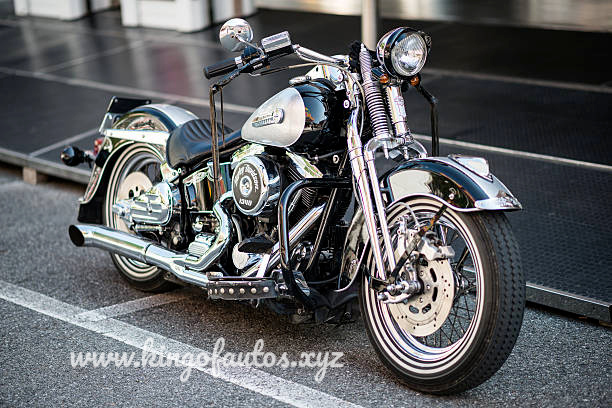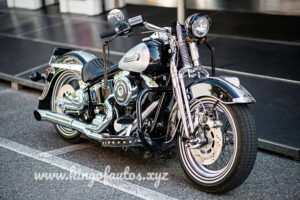The Brief History Of Harley Davidson Motar Company
Not many cruiser brands order a similar name acknowledgment as Harley-Davidson. The famous American organization laid out in the mid 1900s has fostered a tremendous following and stays one of the world’s biggest makers in the business.
Lifelong companions William Harley and Arthur Davidson are the ones to credit for the production of the brand. Both had an early interest with bikes and chipped away at models for cruisers in their extra time.
This prompted the making of their most memorable bike in 1903 in Milwaukee, Wisconsin, and brought about a vertical direction that helped them through a scope of changes and battles as the years progressed.
In 1983, Motorcycle Mechanics Institute (MMI) and Harley-Davidson fostered a relationship that prompted the making of a few particular elective projects accessible to understudies keen on working with the brand.
Continue to peruse to look further into this relationship as well as more on the historical backdrop of Harley-Davidson.
Harley-Davidson Early Days
Harley-Davidson pioneers William Harley and Arthur Davidson cooperated on the model for their organization’s most memorable cruiser in a 10-by-15-foot shed. It was finished in 1903, yet they quickly started dealing with a fresher and more present day bicycle.
Another model highlighting a greater motor was finished in 1904. This model partook in cruiser hustling at State Fair Park in Milwaukee. The primary creation bicycle, the Harley-Davidson Model No. 1®, was delivered in 1905 and was basically the same as the initial two bicycles created.
The organization was delivering finished bicycles on a restricted premise, nonetheless. The principal Harley-Davidson seller was Carl H. Lang of Chicago, who sold three of the five bicycles that had been implicit the lawn shed.
The primary Harley-Davidson plant was underlying 1906 on Chestnut Street in Milwaukee, where the organization delivered 50 bicycles that year. The organization was formally consolidated in 1907. At this point, Arthur’s two siblings, Walter and William Davidson, had joined the drive.
In 1917, around half of Harley’s business went to the U.S. military for use in World War I. The principal administration school was worked in Milwaukee to prepare Army mechanics.
Harley-Davidson finished its office on Juneau Avenue in 1920. It was seven stories high — yet exists today for use as the corporate office community.
From 1941 to 1945, Harley-Davidson was illuminating sellers that, because of responsibilities with the Army, vendors were promised one new bicycle each model year as long as necessary. An expected 88,000 bikes were worked for the military as of now, alongside a colossal stock of fix parts.
Creation expanded during that time with the brand flourishing through a scope of verifiable occasions. Right up ’til now, Harley-Davidson stays a notorious American bike brand.
Models by Decade
While it would take for a spell to list all the different Harley-Davidson® models by year, separating it by many years helps feature a portion of the achievements the brand has had.
Following up the principal creation bicycle in 1905, the organization presented its most memorable V-twin fueled cruiser in 1909. This prompted a leap underway and more developments as the many years went on.
1910s Harley-Davidson® Motorcycles
1911 7D®: The principal fruitful V-twin created by Harley-Davidson, the 7D® aided champion a motor arrangement that has been utilized reliably in years since.
1914 10-F®: This V-twin was the main bicycle to include two rates, which was a progression for the brand. It likewise highlighted a “step-starter” like the cutting edge kick-starter.
1920s Harley-Davidson® Motorcycles
1925 JD®: The presentation of this model assisted the organization with having an effect in the business to the extent that styling, with the gas tank wearing an adjusted, tear shape.
1929 D-Series®: To rival the Scout being created by Indian Motorcycle, Harley-Davidson delivered the D-Series®, which presented the side-valve, 45ci, V-twin motor known as the “45” or flathead.
1930s Harley-Davidson® Motorcycles
1932 R-Series®: To supplant the D-Series®, the R-Series® was presented with new styling that aided shape Harley-Davidson as a staple of Americana. It likewise helped the organization through the Great Depression.
1937 UL®: As the organization got back in the saddle from the Great Depression, Harley-Davidson delivered the UL®, which was a Sport Solo® model highlighting a recycling oil framework and four-speed transmission.
1940s Harley-Davidson® Motorcycles
1942 WLA®: The WLA® was created for the Army during World War II. It had a V-twin motor and was fitted with exceptional highlights and gear for the conflict.
1948 FL®: There were a few changes acquainted with Harley-Davidson plans with the 1948 FL, which included a new “Panhead” V-twin motor.
1950s Harley-Davidson® Motorcycles
1952 K-Model®: The K-Model® was planned with the picture of a race bicycle as a top priority, and Harley-Davidson needed an option that could be lighter than a portion of its past models.
1957 Sportster® XL: The Sportster® was presented with the expectations of getting bicycles to clients the nation over. The model was created to be practical and simple to move.
1960s Harley-Davidson® Motorcycles
1961 Super 10®: The Super 10® was promoted as a more modest, passage level bike. The vehicle included a two-stroke, air-cooled motor.
1965 FL Electra Glide®: This model included the remainder of the Panhead motors. It was likewise the primary Harley-Davidson with an electric beginning. Because of this mix, it has turned into a well known gatherer’s bicycle.
1970s Harley-Davidson® Motorcycles
1971 Factory Experimental FX Super Glide®: This model was showcased as the primary custom in the chopper development from Harley-Davidson. It was essential for a midrange line that offered the treatment of a Sportster® with the force of a major twin motor.
1977 FXS Low Rider®: A variety of the FX Super Glide®, the Low Rider® bike was presented and highlighted broadened forks. It was a moment hit and surpassed different models during its most memorable creation year.
1980s Harley-Davidson® Motorcycles
1980 FXB Sturgis®: Harley-Davidson delivered this model to respect the noteworthy Sturgis cruiser rally held every year in South Dakota. It highlighted exemplary dark paint with red trim and was a restricted release model, with something like 1,500 made.
1984 FX/FL Softail®: A disclosure came during the ’80s with the presentation of the Softail® stage, which was intended to seem to be Harley-Davidsons from the ’40s and ’50s. The suspension highlighted secret shocks.
1990s Harley-Davidson® Motorcycles
1990 FLSTF Fat Boy®: The Fat Boy® was a cruiser intended for Daytona Bike Week in 1988 and 1989. The creation model went available in 1990.
Harley-Davidson Fat Boy®
1992 FXDB Daytona®: A recognition was made to Daytona Beach with the development of the FXDB Daytona® cruiser. It included chrome trim and a pearl paint work. Just 1,700 were assembled.
2000s Harley-Davidson® Motorcycles
2002 FXDWG3®: This model highlighted an industrial facility custom look that was intended for the individuals who needed something a piece unique. It highlighted custom mirror stalks and grasps, as well as paint emphasized with flares.
2007 FXDB Dyna Street Bob®: The plan of the Street Bob® was propelled by moderate styling. It dumped a front seat and stakes for a more smoothed out look and engaged the independent rider.
2010s Harley-Davidson® Motorcycles
2014 XG Street®: This energetic dislodging bicycle was acquainted with catch a more youthful market. It copied the K-Model® in that it was advertised as a reasonable and fun choice.
2019 Livewire™: The Livewire™ was the principal electric vehicle planned by Harley-Davidson, including a battery that gives 146 miles of city range.
These are only a small bunch of Harley-Davidson® models created over its long history. Understudies have the chance to deal with both late-and early-model bicycles when they sign up for producer explicit electives at MMI.
Harley-Davidson Electives at MMI
The connection between Harley-Davidson and MMI was laid out in 1983 and prompted the improvement of a few elective choices for understudies needing to acquire specific involvement in the brand.
An understudy deals with a Harley-Davidson® cruiser motor in a MMI lab.
When understudies total the center Motorcycle Technician Training program, they can proceed with their preparation in the Harley-Davidson Late Model elective, which is 24 weeks in length. Courses include:
H-D Tech 1: Introduction to Vehicle Service: Topics covered incorporate vendor the executives frameworks, involved adjusting of guiding head congregations and suspensions, and the choice to finish pre-evaluations required for the Harley-Davidson PHD program.
H-D Tech 2: Introduction to Powertrain: Harley-Davidson motor history, transmissions and fuel-infusion frameworks are covered during this course.
H-D Vehicle Maintenance: Students are tried on their administration writing abilities as they work on bikes and find out about brake administrations, back tire administrations and that’s just the beginning.
H-D Electrical Diagnostics: Systems covered incorporate charging, turning over and motor administration.
H-D Chassis Service: Service methods for suspension and skeleton parts are covered, as well as data on slowing mechanisms, including antilock slowing down (ABS) frameworks.
H-D Powertrain Service: The attention on powertrains has understudies acting top to bottom administrations and fixes on all parts, including the motor and wheel gatherings.
H-D Dealer Service Operations 1: This is a capstone course centered around administration systems that understudies advanced all through the Late Model program, with errands lined up with the Vehicle and Chassis Service (VCS) course.
H-D Dealer Service Operations 2: This subsequent capstone course has an emphasis on electrical symptomatic methods learned in the Late Model program.
In the wake of moving on from Late Model preparation, understudies can extend their insight further by signing up for the Screamin’ Eagle® execution preparing, which is three weeks in length. This elective is separated into two centers, which are:
Powertrain Performance: Students come out as comfortable with the Screamin’ Eagle® line of execution choices from the brand.
Dynamometer Operations: Students figure out how to utilize the Dynojet® dynamometer to analyze drivability issues.
At last, the Harley-Davidson Early Model elective is additionally accessible to alumni of Late Model preparation. Throughout about a month and a half, the Early Model elective assists understudies with extending their insight on Harley-Davidson® bicycles dating to 1936. It’s parted into two segments:
H-D Early Model 1: The principal half of the elective covers enormous twin motors, side-valve and iron XL motors, and transmissions and grasps.
H-D Early Model 2: The last part covers carburetion, early frame upkeep and early electrical frameworks. A last survey is likewise directed.
Program Benefits
The Harley-Davidson particular preparation program is presented at two MMI grounds. The elective choices offer various advantages for the people who decide to enlist, including:
Harley-Davidson PHD appraisals: Students have the valuable chance to decide to become familiar with the PHD evaluation process, which is significant for the Technician Recognition program. PHD course credits can be procured for VCS as well as electrical diagnostics.
Choices: The Late Model elective is accessible for the individuals who have finished the center Motorcycle Technician program, and Screamin’ Eagle® and Early Model electives are accessible for the people who have finished the Late Model elective.
Current innovation: Courses and points canvassed in the Harley-Davidson electives are lined up with Harley-Davidson University™.
Certifications: Graduates get a year of work experience they can apply toward Harley-Davidson’s field acknowledgment program, and they are likewise equipped for work in showrooms.
Get Advanced Harley-Davidson Training
In the event that you have an energy for Harley-Davidson® cruisers with a craving to function as a bike professional, there could be no more excellent method for getting ready than with specific preparation at MMI. Procure qualifications and feel certain after graduation realizing you’re ready for a section level profession at a Harley-Davidson® dealership.1
Get more familiar with the program by mentioning data here or by calling 1-800-834-7308.

